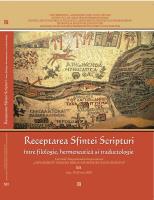Simbolismul sării la Sfântul Irineu de Lyon. Studiu de caz: transformarea femeii lui Lot în stâlp de sare (Fac. 19:26)
The Symbolism of Salt in St Irenaeus of Lyon. Case Study: The Transformation of Lot's Wife into a Pillar of Salt (Gen. 19:26)
Author(s): Dimitrie DalidisSubject(s): Anthropology, Semiology, Biblical studies
Published by: Editura Universităţii »Alexandru Ioan Cuza« din Iaşi
Keywords: salt; Irenaeus; incorruptibility; Lot; wife; Genesis; symbolism;
Summary/Abstract: This study examines the spiritual dimension of salt by exploring the religious symbolism attributed to salt in the Old Testament and patristic writings. We will deepen the biblical episode of the transformation of Lot's wife into a pillar of salt (Gen. 19:26), its theological significance and its reception in the work and thought of Saint Irenaeus of Lyon. It also explores the anthropological perspective of Saint Irenaeus of Lyon and the concept of incorruptibility. The analysis begins with a philological examination of key terms such as “pillar” and “salt” found in the biblical passage of Genesis 19:26, which describes the transformation of Lot's wife into a pillar of salt. The second part of the study focuses on Saint Irenaeus of Lyon's interpretation of the biblical passage and its connection to the religious symbolism of salt. The study highlights the importance of incorruptibility and the image of the Church as the salt of the earth in Saint Irenaeus' theology. Turning the pillar of salt from a negative symbol into a positive one, Saint Irenaeus represents an impactful and courageous hermeneutical voice in the Church. This interpretative position did not create an echo in subsequent centuries in patristic literature, but neither was it contested.
Journal: Receptarea Sfintei Scripturi: între filologie, hermeneutică şi traductologie
- Issue Year: 12/2023
- Issue No: 1
- Page Range: 161-170
- Page Count: 10
- Language: Romanian

